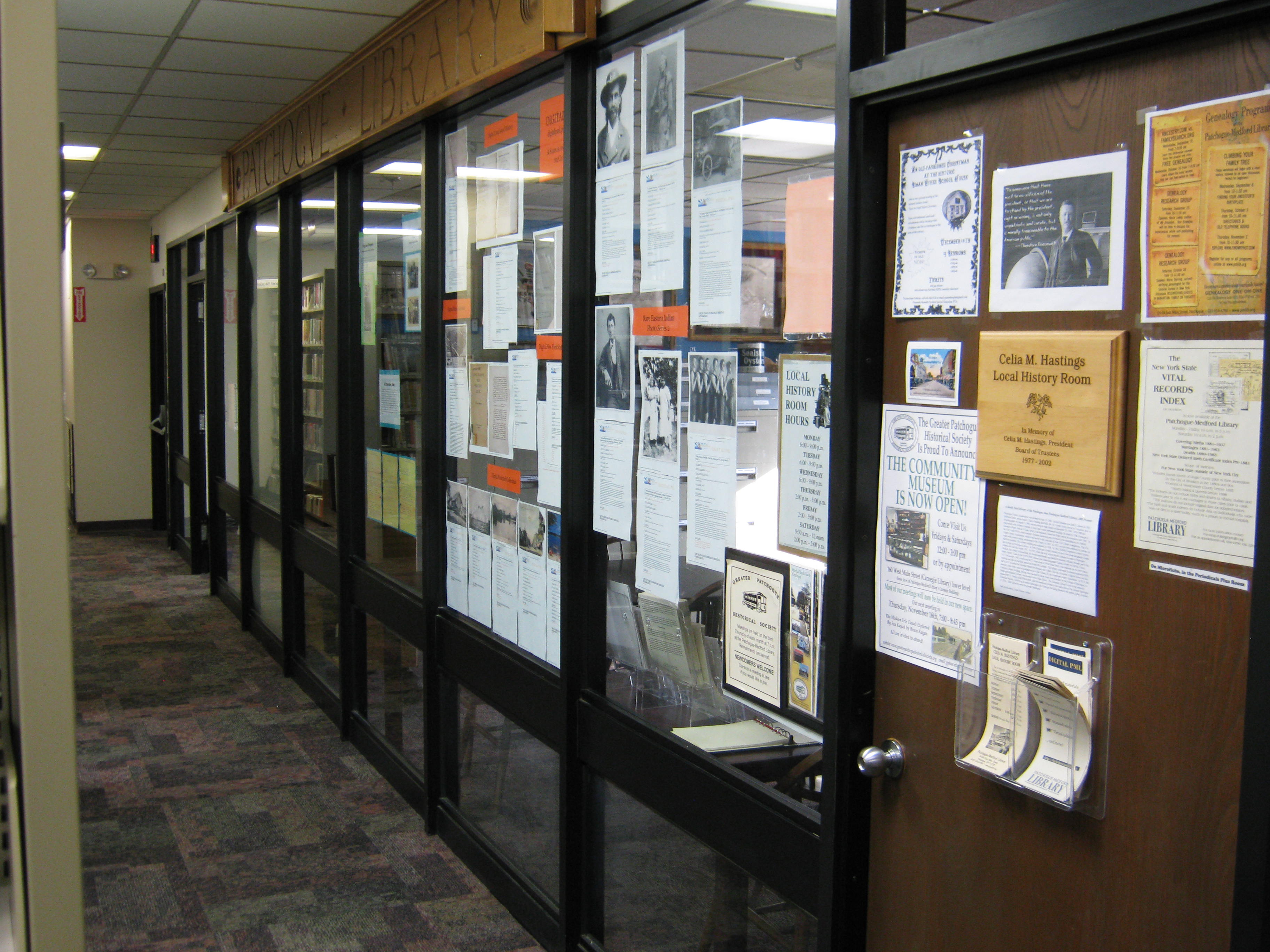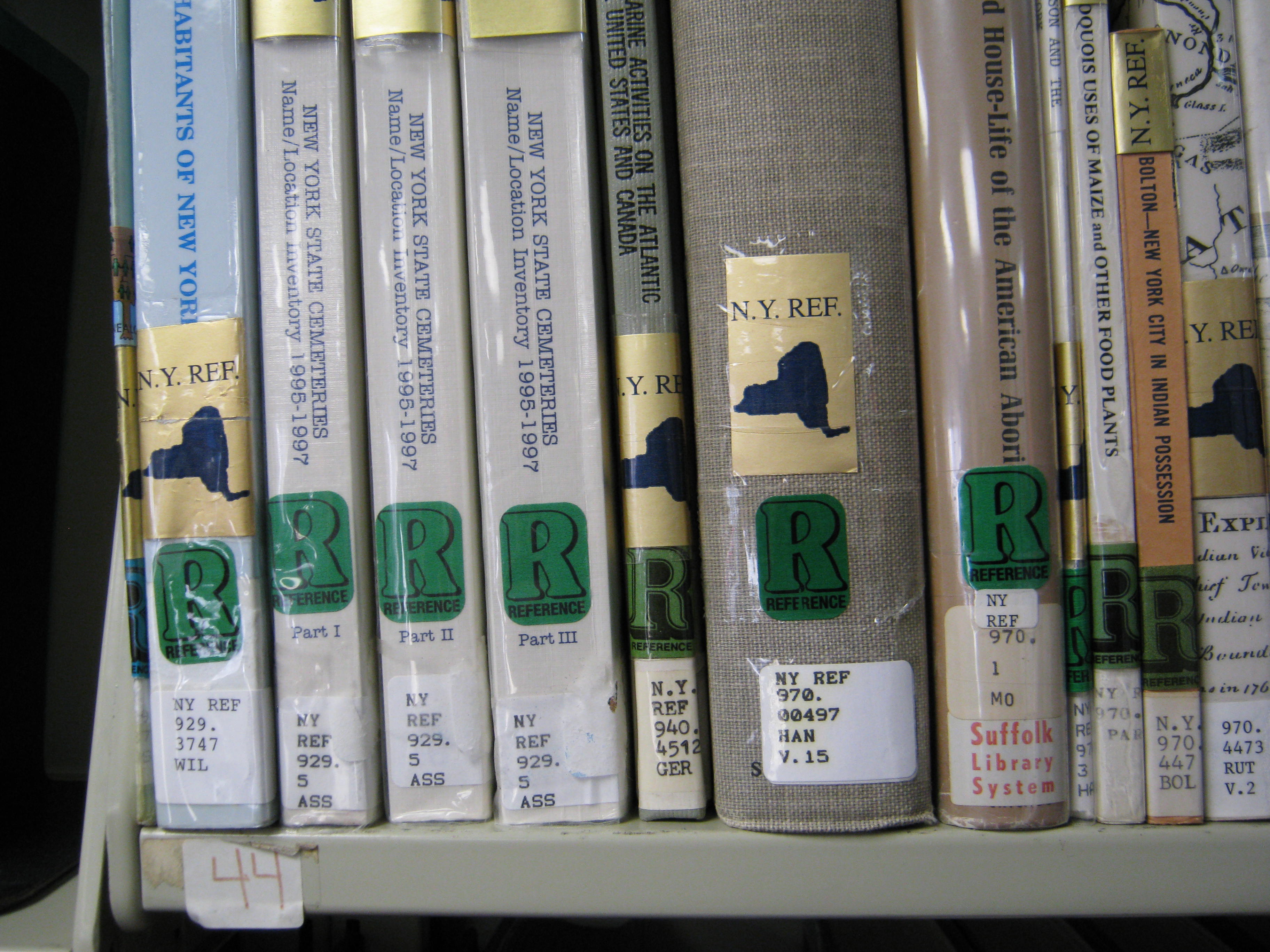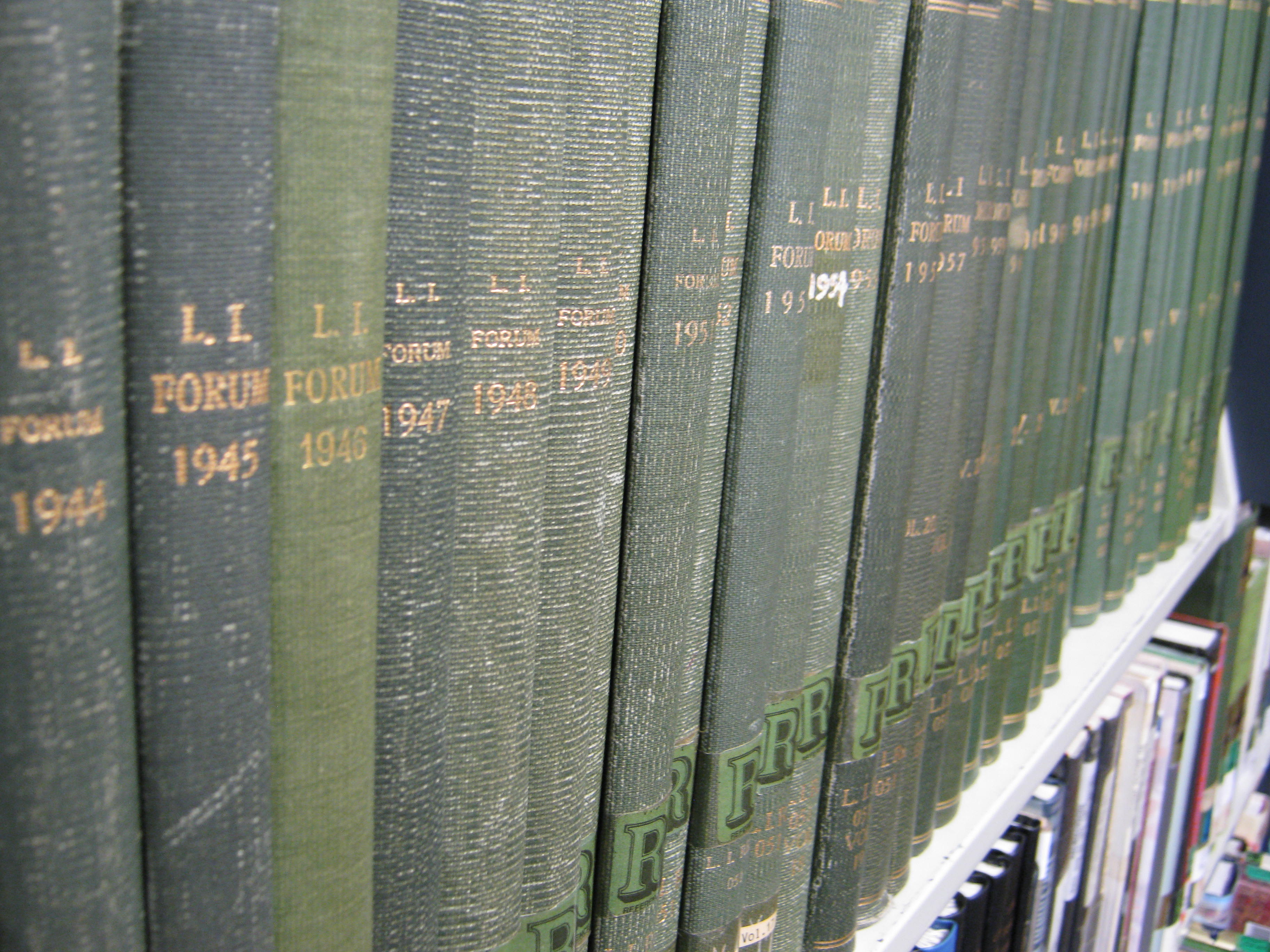- Just before you enter, look up over the windows to your left, at the carved wooden sign, "PATCHOGVE LIBRARY." (The "V" represents a Latin "U", carved in the Roman style.) This sign originally hung over the Carnegie Library Reference Desk (at 10 Lake Street, a short walk away) between 1908-1981. (See also our Walking Tour of Patchogue-Medford Library History. The beautifully restored Carnegie Library building (now located at the corner of West Avenue and West Main Street), reopened in 2017 as PML's Teen Center. Greater Patchogue Historical Society has a museum downstairs.
 The 4 picture windows below the sign, and the door to the room (to their right), with its dedication to Celia M. Hastings, contain occasionally changing exhibits on local, town, county, Long Island regional, or N.Y. State history themes, commemorations, resources developed by the Library, or on the Library’s history.
The 4 picture windows below the sign, and the door to the room (to their right), with its dedication to Celia M. Hastings, contain occasionally changing exhibits on local, town, county, Long Island regional, or N.Y. State history themes, commemorations, resources developed by the Library, or on the Library’s history. - Among exhibits on the Local History Room door you’ll often find posted announcements of local history lectures, meetings, events, competitions, awards, recognitions, or opportunities, as well as samples of new local history publications or research findings. Please be aware that everything in the Room is non-circulating Reference Material, to be used only in the Room, with a Librarian present, in case additional assistance is needed. We take our role as long-term stewards of this material for the community and county seriously. (But, note that outside the Local History Room, there are often circulating copies of the same books in the Library's other collections -- check the Library Catalog -- and there is a photocopier in the Room, itself.)
- As you enter the Local History Room, feel free to say hello! Free handouts are in two racks on the table and on a spinning rack on the free-standing tan cabinet in the center of the room. Public seating is available at the two tables (to your left as you enter the room). Tables occasionally contain displays - especially during historical commemorations and celebrations - that can be temporarily moved for your convenience, if more workspace is needed. Just ask.
- Looking roughly straight ahead as you enter, is the Local History Reference Desk. Feel free to ask the Librarian on duty questions, for guidance and suggestions in using the Room’s collections, help locating material on topics in which you’re interested, and for useful contacts and leads to information, or for a quick orientation tour of the Room or Local History Website (if it’s not busy).
 Stepping forward into the Room, just past the door, to your immediate right, is the New York Reference Collection (identifiable from its NY REF stickers, containing a blue map of the state on a gold background [state colors]). This 1 ½ -bookstack section represents about ¼ of the total NY REF collection. The rest is in NY REF Storage, due to spatial limits of the Room. Both parts of the collection are recorded in the Library Catalog. Material here includes selected State, NYS regional, NYS county, NYC (county, borough and neighborhood) studies, reprints of historic documents, as well as books and pamphlets on various themes in the history of the State (arranged by Dewey Decimal Number).
Stepping forward into the Room, just past the door, to your immediate right, is the New York Reference Collection (identifiable from its NY REF stickers, containing a blue map of the state on a gold background [state colors]). This 1 ½ -bookstack section represents about ¼ of the total NY REF collection. The rest is in NY REF Storage, due to spatial limits of the Room. Both parts of the collection are recorded in the Library Catalog. Material here includes selected State, NYS regional, NYS county, NYC (county, borough and neighborhood) studies, reprints of historic documents, as well as books and pamphlets on various themes in the history of the State (arranged by Dewey Decimal Number).- The Long Island Reference Collection (LI REF) comprises the largest section of the Room’s book shelving, behind and wrapping around to the right side of the Reference Desk. This represents ½ the total LI REF collection, the rest being in LI REF Storage. Both of these collections and the collections in storage are listed in the Library Catalog.
- Long Island Genealogy is mainly found in the in the Dewey 920’s, in the corner section, on the right side. This is one of the most heavily used parts of the Room. A recently revised, expanded, online classified bibliography of L.I. genealogical holdings (Surnames listed in some of the items are now searchable, using Control + F[ind]).
- Another very heavily used section is Geographically-Oriented, and concerns the L.I. Region, its counties, towns, villages (incorporated and unincorporated), customary village groupings, and L.I.’s outer islands. Dewey lumps anything smaller than a county, under the county, then proceeds to systematically scatter it by author, which isn't very practical, when trying to make this material easily accessible to the public. So, our collection has been reconfigured to be grouped alphabetically by region (2-county [LI-R-2] and 4 county [LI-R-4] studies), county (Co-Nass; Co-Suff), individual town (T-), village (V-), customary village group (VGP-), and outer island (I-), vastly improving access, speeding research, and improving service. The organization scheme is found in, A Guide to Localizing Dewey for Long Island Use, which has been adapted for use by a quite a few Suffolk County public libraries, while also serving Patchogue-Medford Library's role as central library for the county. A short mnemonic abbreviation (sounds like what it is) is used for each place: e.g., T-HUNT = Town of Huntington; V-PATCH = Patchogue; VGP-3VILL = Three Village Area; I-FISH = Fishers Island.
 Just before the NY REF section is the Long Island Forum, 1938-2004, a now defunct, popularly-written Long Island local history magazine (in multicolored volumes, in greens, gray, black, blue, and white) still valuable and much used; for which there is an online cumulative index, 1938-2003 @ https://history.pmlib.org/gentools/longislandforumindex, that may be searched at home or in the Library.
Just before the NY REF section is the Long Island Forum, 1938-2004, a now defunct, popularly-written Long Island local history magazine (in multicolored volumes, in greens, gray, black, blue, and white) still valuable and much used; for which there is an online cumulative index, 1938-2003 @ https://history.pmlib.org/gentools/longislandforumindex, that may be searched at home or in the Library.
- Make a left between the first table and the Local History Reference Desk, straight ahead you’ll see a row of 6 labeled tan file cabinets. These are the Long Island Vertical File (LIVF): 24 file cabinet drawers containing articles, pamphlets, newspaper clippings, illustrations, photos, and a variety of other materials, arranged from A to Z, under a series of Library of Congress subject headings, on various aspects of Long Island history. The Subject Heading List is available online, on our website. Most subject files are heavily subdivided, allowing greater precision and usually saving access time for everyone who uses it. (Note: The Medford files are located here.)
- Past the wire book truck (on your right, behind the central tan cabinet with the spinning handout rack), are 3 more tan file cabinets, containing the L.I.–Patchogue Vertical Files, organized in similar fashion to the L.I. Vertical Files, under subjects, from A-Z, with numerous subtopics. These are also listed on the online Subject Heading List. (The smaller cabinet also contains project material. That section is for librarians’ use.)
- Left of the L.I. - Patchogue V.F.’s is a Photocopier for public use by researchers. It makes 8 ½” x 11” or 8 ½ x 14” black & white copies. Copies are 10 cents a page. Pay at the Circulation Desk after making your copies.
- Left of the Photocopier and Right of the LIVF are 15 large horizontal drawers: Map and Atlas Cabinets. Patchogue and Medford maps are housed in the top two drawers. Other maps are designated by geographic area covered or theme. There are also copies of selected U.S. Coastal Survey charts (for the immediate area) and other maps in tubes and boxes; and a number of atlases in our Archival Collections (ask Librarian). Above the Map & Atlas Cabinets are wooden framed Aerial Photos taken and donated courtesy of Frank Mooney, Sr., former editor of Patchogue's Main Street Press. A number of Audiovisual Items and several Oral Histories (on DVD and CD) are to the left of the aerial photos, as is the former Local History Room Card Catalog File Cabinet, for those interested in library history, or who have never seen one. Photographs tend to be primarily, though not exclusively, of a small area of Patchogue, centered on the "4 Corners" (junction of Main Street and Ocean Avenue, usually postcard images. But there are exceptions Digital PML (online) contains a growing number of collections of photos, postcards, books and other materials.
- Left of the Map Cabinets, above the LIVF Cabinets is the main Archival Collection, which includes, atlases, scrapbooks, postcards, photographs, and library history.
- Left of the Archival boxes, backing the 5th window, is a small section of Local History Periodicals. In creating space for maps (below these two shelves), it became necessary to transfer some of the periodical collection to storage, due to spatial constraints. A subject index to some of the earlier volumes of the Suffolk County Historical Society Register, prepared by staff, now accompanies the Princeton files of the Register. Long Island Historical Journal (Stony Brook University) was recently indexed, now available online, as is the LIHJ’s successor publication (a free, public access site), Long Island History Journal, both courtesy of the Special Collections staff of the University’s Melville Library.
Electronic Resources: Our Local History Website is divided, as you can see at the top of this web page six main sections of pull-down menus. It ranges from New York State to the very local level history, includes thematic material, finding aids, many home grown or linked reference tools, selected full text (often searchable downloadable items), from our collection, and many links to other collections. Its main virtue is its organization, and many of its now over 100 web pages are mutually supportive. (Note: A number of the Library’s history-related subscriptions involve publisher- or distributor-imposed public use restrictions. These may be accessed only within the Library, but are available whenever the Library is open and there is a free computer.)
For more information or for a general or specialized tour of the Room and its resources, contact us.
That concludes the tour. Hope you enjoyed it and found it informative and worthwhile. Hope to see you again.
